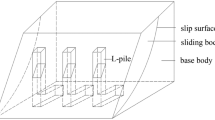Abstract
Stabilizing piles are widely used as an effective and economic reinforcement approach for slopes. Reasonable designs of pile reinforcement depend on the understanding of reinforcement mechanism of slopes. A series of centrifuge model tests were conducted on the pile-reinforced slopes and corresponding unreinforced slopes under self-weight and vertical loading conditions. The deformation of the slope was measured using image-based analysis and employed to investigate the pile reinforcement mechanism. The test results showed that the piles significantly reduced the deformation and changed the deformation distribution of the slope, and prevented the failure occurred in the unreinforced slope. The pile influence zone was determined according to the inflection points on the distribution curves of horizontal displacement, which comprehensively described the features of the pile–slope interaction and the characteristics of reinforced slopes. The concepts of anti-shear effect and compression effect were proposed to quantitatively describe the restriction features of the piles on the deformation of the slope, namely the reduction in the shear deformation and the increase in the compression deformation, respectively. The pile reinforcement effect mainly occurred in the pile influence zone and decreased with increasing distance from the piles. There was a dominated compression effect in the vicinities of the piles. The compression effect developed upwards in the slope with a transmission to the anti-shear effect. The anti-shear effect became significantly dominated near the slip surface and prevented the failure that occurred in the unreinforced slope.












Similar content being viewed by others
References
Anbarasu K, Sengupta A, Gupta S (2010) Mechanism of activation of the Lanta Khola landslide in Sikkim Himalayas. Landslides 7(2):135–147
Ashford SA, Juirnarongrit T, Sugano T, Hamada M (2006) Soil-pile response to blast-induced lateral spreading. I: field test. J Geotech Geoenviron Eng 132(2):152–162
Ausilio E, Conte E, Dente G (2001) Stability analysis of slopes reinforced with piles. Comput Geotech 28(8):591–611
Cai F, Ugai K (2000) Numerical analysis of the stability of a slope reinforced with piles. Soils Found 40(1):73–84
El Sawwaf MA (2005) Strip footing behavior on pile and sheet pile-stabilized sand slope. J Geotech Geoenviron Eng 131(6):705–715
Ellis EA, Durrani IK, Reddish DJ (2010) Numerical modelling of discrete pile rows for slope stability and generic guidance for design. Geotechnique 60(3):185–195
Gallagher RH (1974) Finite element analysis. Prentice-Hall, New Jersey
Hu Y, Zhang G, Zhang JM, Lee CF (2010) Centrifuge modeling of geotextile-reinforced cohesive slopes. Geotext Geomembr 28(1):12–22
Ito T, Matsui T, Hong PW (1981) Design method for stabilizing piles against landslide one row of piles. Soils Found 21(1):21–37
Jeong S, Kim B, Won J, Lee J (2003) Uncoupled analysis of stabilizing piles in weathered slopes. Comput Geotech 30(8):671–682
Jiang Y, Han J, Zheng G (2014) Numerical analysis of a pile-slab-supported railway embankment. Acta Geotech 9(3):499–511
Kanagasabai S, Smethurst JA, Powrie W (2011) Three-dimensional numerical modelling of discrete piles used to stabilize landslides. Can Geotech J 48(9):1393–1411
Kang GC, Song YS, Kim TH (2009) Behavior and stability of a large-scale cut slope considering reinforcement stages. Landslides 6(3):263–272
Raj M, Sengupta A (2014) Rain-triggered slope failure of the railway embankment at Malda, India. Acta Geotech 9(5):789–798
Rao SVK, Nasr Ahmed MA (2010) Experimental and theoretical studies of vertical piles reinforced sand slopes loaded with strip footing. Geotech Test J 33(5):385–396
Rogers CDF, Glendinning S (1997) Improvement of clay soils in situ using lime piles in the UK. Eng Geol 47(3):243–257
Smethurst JA, Powrie W (2007) Monitoring and analysis of the bending behaviour of discrete piles used to stabilise a railway embankment. Geotechnique 57(8):663–677
Song YS, Hong WP, Woo KS (2012) Behavior and analysis of stabilizing piles installed in a cut slope during heavy rainfall. Eng Geol 129–130:56–67
Viswanadham BVS, Rajesh S (2009) Centrifuge model tests on clay based engineered barriers subjected to differential settlements. Appl Clay Sci 42(3–4):460–472
Wang LP, Zhang G (2014) Centrifuge model test study on pile reinforcement behavior of cohesive soil slopes under earthquake conditions. Landslides 11(2):213–223
Wang LP, Zhang G (2014) Progressive failure behavior of pile-reinforced clay slopes under surface load conditions. Environ Earth Sci 71(12):5007–5016
Wang LP, Zhang G (2015) In flight simulation of pile installation in slopes in centrifuge model tests. Geotech Test J 38(1):50–60
Wei WB, Cheng YM (2009) Strength reduction analysis for slope reinforced with one row of piles. Comput Geotech 36(7):1176–1185
Yu YZ, Deng LJ, Sun X, Lu H (2010) Centrifuge modeling of dynamic behavior of pile-reinforced slopes during earthquakes. J Cent South Univ Tech 17(5):1070–1078
Zhang G, Hu Y, Zhang JM (2009) New image analysis-based displacement-measurement system for centrifuge modeling tests. Measurement 42(1):87–96
Zhang G, Wang LP (2010) Stability analysis of strain-softening slope reinforced with stabilizing piles. J Geotech Geoenviron Eng 136(11):1578–1582
Zhang G, Wang LP (2016) Integrated analysis of a coupled mechanism for the failure processes of pile-reinforced slopes. Acta Geotech 11(4):941–952
Acknowledgements
The study is supported by the National Natural Science Foundation of China (Grant No. 51479096), Tsinghua University Initiative Scientific Research Program, and National Program for Support of Top-notch Young Professionals.
Author information
Authors and Affiliations
Corresponding author
Rights and permissions
About this article
Cite this article
Zhang, G., Wang, L. & Wang, Y. Pile reinforcement mechanism of soil slopes. Acta Geotech. 12, 1035–1046 (2017). https://doi.org/10.1007/s11440-017-0543-3
Received:
Accepted:
Published:
Issue Date:
DOI: https://doi.org/10.1007/s11440-017-0543-3




